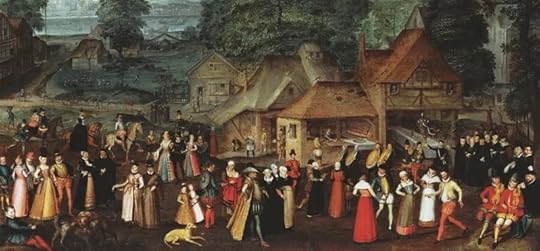How To Be a Tudor: A Dawn-to-Dusk Guide to Tudor Life by Ruth Goodman
My rating: 4 of 5 stars
Just like with her How to Be a Victorian, Ruth Goodman is going for the immersive everyday experience of what life in another often-depicted historical period in Britain would be actually like. This time it’s Tudor England – and we get to read about clothes, food, education, hygiene, work, entertainment. Some of these things she actually tried out in historical recreations and therefore can give actual real-life account (our superior attitude with frequent water/soap washes does not really decrease the smelliness much compared to the Tudor linen-based hygiene, and soot for toothpaste works just great).
In our time of overall plentiful and cheap food it’s easy to not realize that the majority of people’s income was spent on food which was very expensive, and making that food was not easy. And clothes – the sheer amount of work and resources that went into making them, and how much use a garment left in a will could be. It’s hard to imagine floors covered in rushes, or all the work that would go into making a bed, and how the idea of sleeping arrangements evolved over time (no, bequeathing his second-best bed to his wife in no means signified that Shakespeare didn’t care, but was a decent bequest). And how important your appearance was in determining your standing in the society – “clothes make the man” indeed, with not only sumptuary laws but also emphasis on proper “current” way to walk and stand and generally fashionably peacock around (can’t have your fancy gait be mistaken for that of a lowly plowman!). Oh, and codpieces, of course. And dancing.
When it came to education, I found it pretty amazing that learning reading and writing was not done together; reading was done first and only then (and not for everyone either) came the writing. And you had to make your own ink and writing implements. Forget about the misconception of child brides – the average marrying age for women was 24 and 26 for men. And I never had a reason to contemplate the difference between using oxen and horses for plowing. Baking in Tudor ovens also seems to have been a special skill. And if you were poor, your meals were pretty much bread with bread and some bread with that – for breakfast, dinner and supper.
It’s a very practical book full of common sense and yet with a peppering of humor throughout, and, just like her Victorian book, puts a lot of emphasis on women and classes other than the upper crust of the society. Just like Ian Mortimer’s “Time Traveler’s Guides”, Ruth Goodman’s books are great in making you appreciate what it would feel like to actually live in the depths of history. But it does go a bit overboard on detail in some sections which may be a bit too much for those of us not as well-versed in the minutiae of Tudor life re-enactments — but then Goodman does manage to compensate for her detail overload with her sincerely genuine unbridled enthusiasm.
4 stars.



fascinating!
LikeLike
Indeed! I also found the BBC TV series on Tudor Farm with Ruth Goodman and I love it!
LikeLiked by 1 person